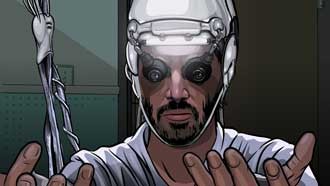Linklater’s much-anticipated project doesn’t stray too far from the original material — and that’s a good thing
The fiction of Philip K. Dick — who is often labeled a “science-fiction author,” though his career isn’t so easily pigeonholed — has been mined by a dozen or so movies over the years. Whether the end results have been good (Blade Runner) or forgettable (Paycheck), they generally have borne only passing resemblance to the stories that inspired them. It seems that while filmmakers find the author’s imaginative leaps too good to pass up, the ins and outs of his dark worldview are too much to follow faithfully.
| Keanu Reeves finally gets animated in Richard Linklater’s adaptation of Philip K. Dick’s A Scanner Darkly. |
That run of casual adaptation ends with A Scanner Darkly, in which Richard Linklater treats Dick with more respect than many filmmakers give Shakespeare. The PKD cult knew early on that this one would be different: There were rumors that Linklater had flown scholars to Austin long before production began, picking their brains before committing to his shooting script. (Celebrity screenwriter Charlie Kaufman once took a shot at translating the book to the screen, but given his well-documented problems with Adaptation, faithful Dick fans probably breathed a sigh of relief when it was announced that Linklater was adapting Scanner on his own.) Austin access-television star and conspiracy theorist Alex Jones was spotted on set, confirming for anyone who needed proof that the film would be steeped in, not stripped of, paranoia.
When I visited the film’s set just over two years ago (while live-action footage was being shot on high-def video, and before the time-consuming job of transferring it to computer animation was really underway), Linklater told me that Dick’s fans weren’t the only audience he had in mind:
“Did you see Philip K. Dick’s daughters out here earlier?” he asked, referring to the two women I’d spotted chatting with cast members. “I had to go out to the Bay Area and hang out with them a little bit before they’d agree to let us do the movie. This book was personal to their dad, and to them. The youngest daughter actually lived in this very house when she was a little girl — not this house `the run-down South Austin location being used`, but the house it represents in the story. You know, they just wanted to hear my take on it. They were a little worried about the drug thing; I just had to assure them it was kind of ultimately a real anti-drug message.”
Linklater isn’t exactly a “just say no” artist: Dazed and Confused was full of happy, harmless pot-smoking, and when I attended the first Sundance screening of Waking Life, he introduced the film by asking, “How many of you out there tonight are on drugs?” When a few hands went up, he went on: “OK, good. You’re in for a treat. The rest of you, bear with us.”
But for Linklater, as for Dick, a libertarian attitude doesn’t imply endorsement. The author closed his 1977 novel with a note to the reader, admitting that the characters were based on his friends: “They wanted to have a good time, but they were like children playing in the street.” He dedicates the book to a list of friends “who were punished entirely too much for what they did,” whose drug experimentation resulted in death, psychosis, and brain damage — but he warns “there is no moral in this novel ... it does not say they were wrong to play when they should have toiled; it just tells what the consequences were.”
Capturing this mood of sincerely conflicting messages is one of the film’s most impressive accomplishments. Scanner is unambiguous about the fact that “Substance D,” the narcotic to which a large chunk of the populace is addicted, is a brain-killing, life-sapping dead end. But it unrepentantly views the world through addicts’ eyes — not those of a straight world that believes it is fighting a war on drugs, even while segments of its economy rely on addiction.
Scanner’s casting (whether it was intended by the filmmakers or not) is somewhat subversive . The film’s liveliest personality, the one supplying most of its humor, is Robert Downey Jr., whose real-world drug issues are well-known; Harrelson and Ryder are also famous for illicit habits. The only lead who isn’t associated with real-world drug abuse, Reeves, plays the most muddled, muffled character in the story. There are aspects of the world, the film seems to suggest, that are almost unknowable to those who have never known addiction firsthand.
For this reason, Linklater’s decision to animate the film is a crucial one that makes it possible to convey the difference between sober and altered perceptions. As in Waking Life, where animation set the mood for a dreamy stroll through others’ minds, Scanner uses its stylized look to establish, quickly and effectively, its own mindset — this time, a paranoid, reality-questioning one.
“I always envisioned it animated,” Linklater told me. “There was some talk a few years ago, when I first wrote the adaptation, about whether it would be. There’s this kind of mantra that adults don’t want to see an animated film — and maybe they don’t, or they won’t go to the theater to see it.” Happily, the Hollywood stars aligned and gave the filmmaker the chance to do things his way — which is to say, the closest he could imagine to Philip K. Dick’s way.


